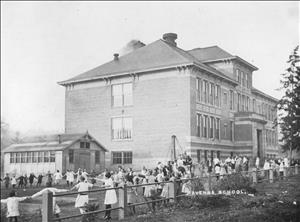This People's History of Ravenna School is taken from Building for Learning: Seattle Public School Histories, 1862-2000 by Nile Thompson and Carolyn J. Marr. That book, published in 2002 by Seattle Public Schools, compiled profiles of all the public school buildings that had been used by the school district since its formation around 1862. The profiles from the book are being made available as People's Histories on HistoryLink.org courtesy of Seattle Public Schools. It should be noted that these essays are from 2000. Some of the buildings profiled are historic, some of recent vintage, and many no longer exist (new names and buildings not included in these profiles from 2000 have been added), but each plays or has played an important role in the education of Seattle's youth.
Ravenna School
From the late 1870s through the 1880s, children living in the area north and east of Green Lake went to Weedin School. Eventually a four-room school was built at the site of the present Green Lake School and Ravenna-area children walked to school there through the woods on an old country road where NE 65th Street is now. Only one house stood on this road between the streets now known as 20th Avenue NE and Roosevelt Way.
An early pioneer named W. W. Beck owned a large tract of land that included what is now Ravenna Park. Beck fenced the park and charged admission to families who wished to come for picnics. The park, named by Beck for a favorite location of his in Europe, was famous for its gigantic trees of spruce, fir, cedar, and hemlock. Eventually he sold the ravine to the city for a public park.
In the mid-1890s, a one-room portable was built near what is now NE 63rd Street and 22nd Avenue NE, and the school took its name from the nearby park. Later another portable was added and, by 1908, nearly 50 children studied there under two young teachers. Beginning in 1907 Ravenna School operated as an annex to Fairview.
The school property was very small and poorly drained. In 1909, a larger four-acre tract was purchased at NE 68th Street and 22nd Avenue NE, some five blocks to the north, and two portables were erected there to serve as Fairview's annex.
Settlement of the area increased rapidly and a permanent building was constructed on the site, even though it was not within the city limits until 1923. The new building opened in fall 1911 as an independent school.
In 1923, with enrollment approaching 500 students, a south-wing addition of 11 classrooms and an auditorium was completed. The playfield was also enlarged through the purchase of two acres to the west.
The playfield gained even more space in 1950 with additional land to the south. That year, the school reached its peak enrollment of 768 students.
The opening of Eckstein Junior High School in 1950 meant removal of grades 7 and 8, which left the building filled but eliminated several portables. By 1961, Ravenna employed a total of 24 teachers, including one for reading-library, and the student population continued to grow. Three portables were used for classrooms and a double portable for a gym.
During the 1973-74 school year, Ravenna's students and teachers were assigned to neighboring schools while the building was remodeled. At the south side of the school, a gym was constructed as a separate building. In the main building, the library was remodeled and in the 1921 addition a kindergarten was added to the lower level. Reopening in fall 1974, the newly remodeled Ravenna became an "open concept" school with several of its permanent walls removed to accommodate this format of instruction.
In 1978-79, Ravenna participated in the district's desegregation program by forming a triad with Green Lake and Colman, with Ravenna housing grades K, 3-5. In June 1981, Ravenna closed because of declining enrollment and shrinking district financial resources. At the time of its closure, the school's student population was 205.
The building was sold to the city and since 1986 has housed the Ravenna School Apartments for seniors on its upper floors, along with a senior center and community center on its lower level. Once sold to the city, the structure was eligible for federal funds, which were used to construct a new Seattle Parks Department gymnasium and a senior center.
Details:
Name: Ravenna School
Location: NE 63rd Street & 22nd Avenue NE
Building: 1-room portable mid-1890s: Opened
n.a.: Second portable added
1907-09: Operated as annex to Fairview
1909: Closed
Name: Ravenna School
Location: 6545 Ravenna Avenue NE
Building: 9-room brick and concrete
Architect: Edgar Blair
Site: 2.07 acres
1911: Opened
1923: Addition (n.a.); site expanded to 3.24 acres
1950: Site expanded to 4.5 acres
1973-74: Addition (n.a.)
1981: Closed in June
1984: Sold to City of Seattle
Use of Ravenna School site in 2000
Ravenna School Apartments, senior center, and parks department gym

